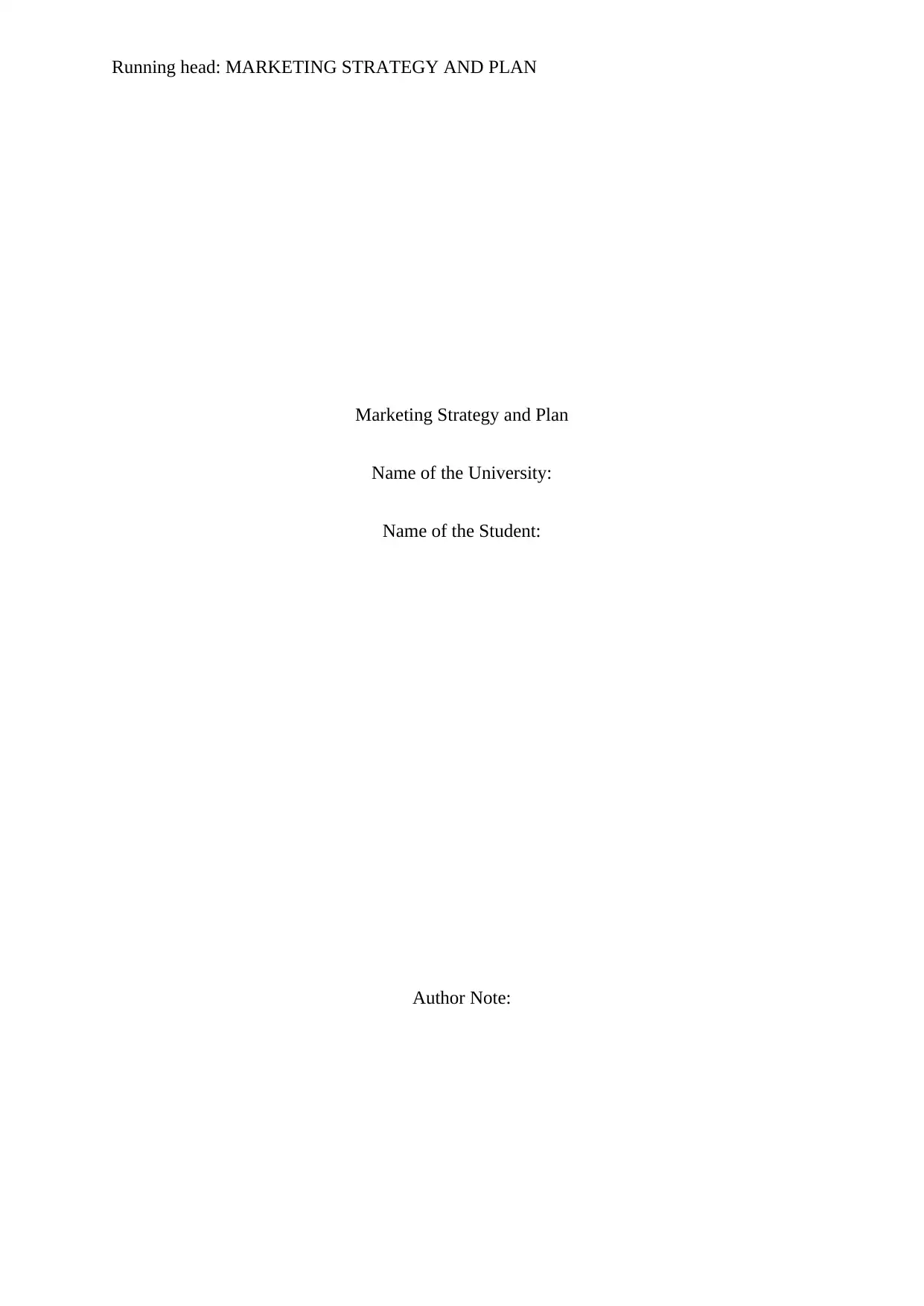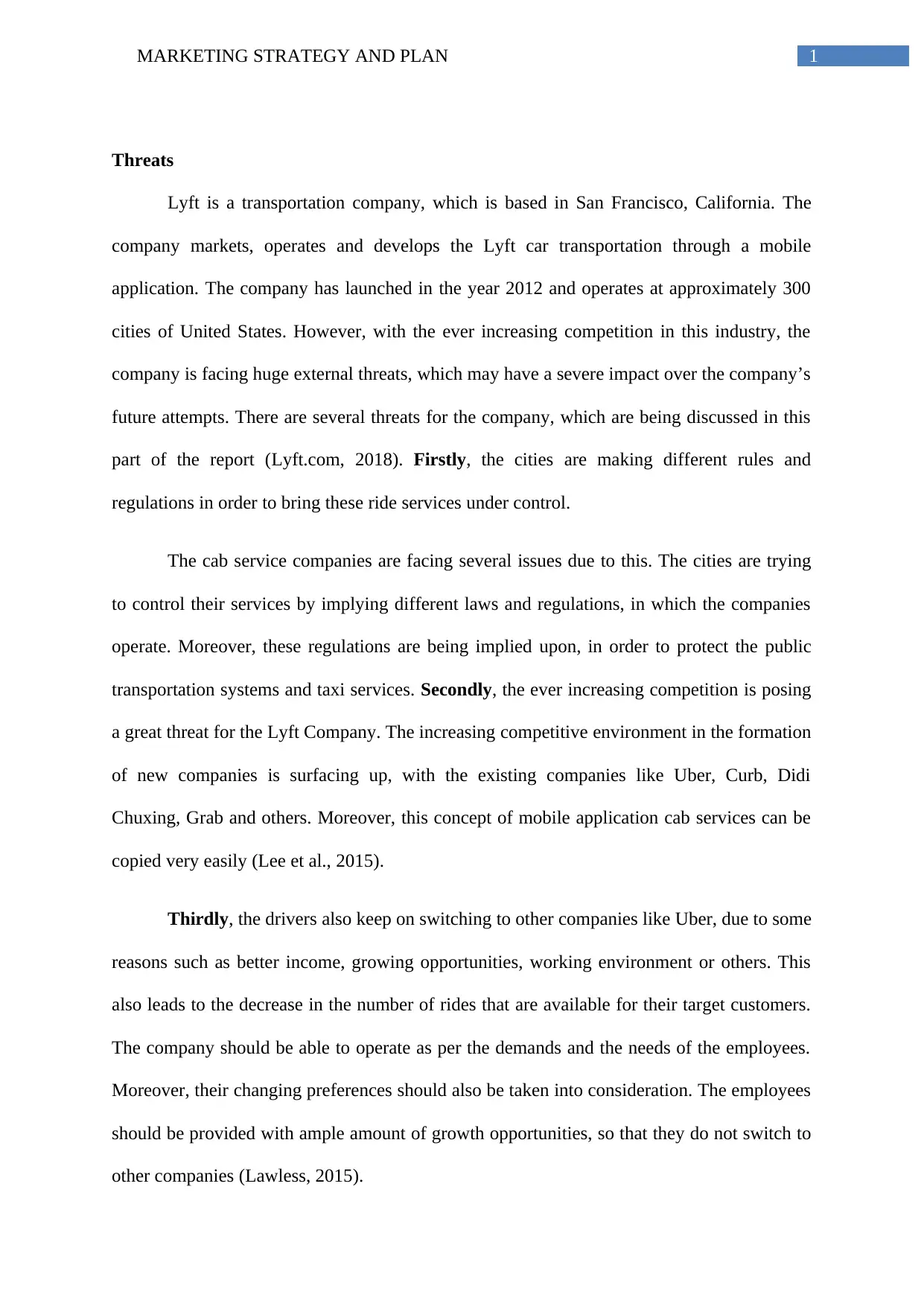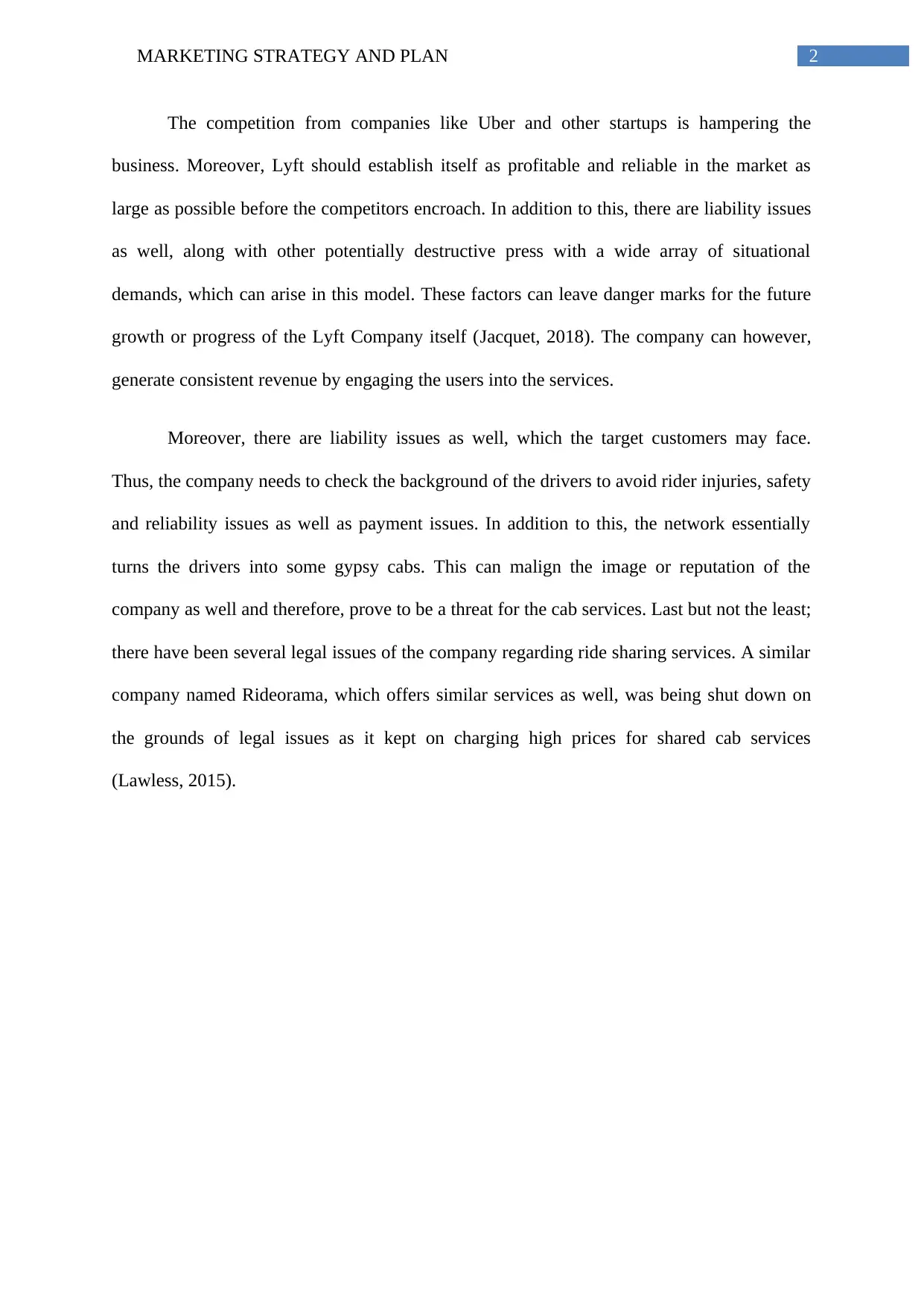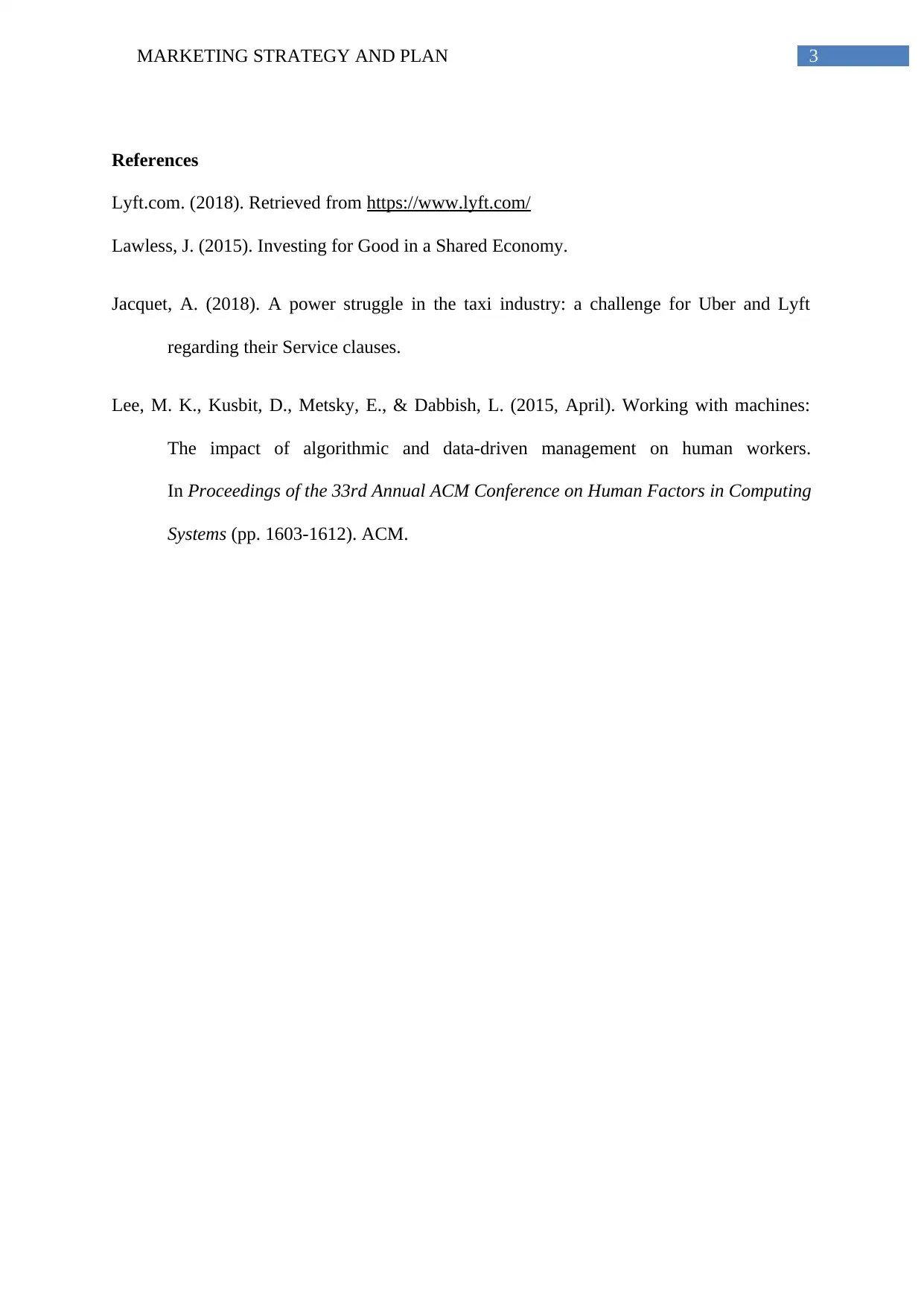CMKT100 Principles of Marketing: Lyft Strategy Analysis Report
VerifiedAdded on 2023/06/10
|4
|762
|429
Report
AI Summary
This report provides a situation analysis of Lyft's marketing strategy, identifying key threats such as increasing regulations, intense competition from companies like Uber, and driver retention issues. The analysis highlights the challenges Lyft faces in establishing profitability and reliability amidst a dynamic market. It also addresses potential liability concerns and legal issues related to ride-sharing services. The report emphasizes the need for Lyft to adapt to changing regulations, improve driver satisfaction, and mitigate risks to maintain its market position. Desklib offers similar solved assignments and study resources for students.

Running head: MARKETING STRATEGY AND PLAN
Marketing Strategy and Plan
Name of the University:
Name of the Student:
Author Note:
Marketing Strategy and Plan
Name of the University:
Name of the Student:
Author Note:
Paraphrase This Document
Need a fresh take? Get an instant paraphrase of this document with our AI Paraphraser

1MARKETING STRATEGY AND PLAN
Threats
Lyft is a transportation company, which is based in San Francisco, California. The
company markets, operates and develops the Lyft car transportation through a mobile
application. The company has launched in the year 2012 and operates at approximately 300
cities of United States. However, with the ever increasing competition in this industry, the
company is facing huge external threats, which may have a severe impact over the company’s
future attempts. There are several threats for the company, which are being discussed in this
part of the report (Lyft.com, 2018). Firstly, the cities are making different rules and
regulations in order to bring these ride services under control.
The cab service companies are facing several issues due to this. The cities are trying
to control their services by implying different laws and regulations, in which the companies
operate. Moreover, these regulations are being implied upon, in order to protect the public
transportation systems and taxi services. Secondly, the ever increasing competition is posing
a great threat for the Lyft Company. The increasing competitive environment in the formation
of new companies is surfacing up, with the existing companies like Uber, Curb, Didi
Chuxing, Grab and others. Moreover, this concept of mobile application cab services can be
copied very easily (Lee et al., 2015).
Thirdly, the drivers also keep on switching to other companies like Uber, due to some
reasons such as better income, growing opportunities, working environment or others. This
also leads to the decrease in the number of rides that are available for their target customers.
The company should be able to operate as per the demands and the needs of the employees.
Moreover, their changing preferences should also be taken into consideration. The employees
should be provided with ample amount of growth opportunities, so that they do not switch to
other companies (Lawless, 2015).
Threats
Lyft is a transportation company, which is based in San Francisco, California. The
company markets, operates and develops the Lyft car transportation through a mobile
application. The company has launched in the year 2012 and operates at approximately 300
cities of United States. However, with the ever increasing competition in this industry, the
company is facing huge external threats, which may have a severe impact over the company’s
future attempts. There are several threats for the company, which are being discussed in this
part of the report (Lyft.com, 2018). Firstly, the cities are making different rules and
regulations in order to bring these ride services under control.
The cab service companies are facing several issues due to this. The cities are trying
to control their services by implying different laws and regulations, in which the companies
operate. Moreover, these regulations are being implied upon, in order to protect the public
transportation systems and taxi services. Secondly, the ever increasing competition is posing
a great threat for the Lyft Company. The increasing competitive environment in the formation
of new companies is surfacing up, with the existing companies like Uber, Curb, Didi
Chuxing, Grab and others. Moreover, this concept of mobile application cab services can be
copied very easily (Lee et al., 2015).
Thirdly, the drivers also keep on switching to other companies like Uber, due to some
reasons such as better income, growing opportunities, working environment or others. This
also leads to the decrease in the number of rides that are available for their target customers.
The company should be able to operate as per the demands and the needs of the employees.
Moreover, their changing preferences should also be taken into consideration. The employees
should be provided with ample amount of growth opportunities, so that they do not switch to
other companies (Lawless, 2015).

2MARKETING STRATEGY AND PLAN
The competition from companies like Uber and other startups is hampering the
business. Moreover, Lyft should establish itself as profitable and reliable in the market as
large as possible before the competitors encroach. In addition to this, there are liability issues
as well, along with other potentially destructive press with a wide array of situational
demands, which can arise in this model. These factors can leave danger marks for the future
growth or progress of the Lyft Company itself (Jacquet, 2018). The company can however,
generate consistent revenue by engaging the users into the services.
Moreover, there are liability issues as well, which the target customers may face.
Thus, the company needs to check the background of the drivers to avoid rider injuries, safety
and reliability issues as well as payment issues. In addition to this, the network essentially
turns the drivers into some gypsy cabs. This can malign the image or reputation of the
company as well and therefore, prove to be a threat for the cab services. Last but not the least;
there have been several legal issues of the company regarding ride sharing services. A similar
company named Rideorama, which offers similar services as well, was being shut down on
the grounds of legal issues as it kept on charging high prices for shared cab services
(Lawless, 2015).
The competition from companies like Uber and other startups is hampering the
business. Moreover, Lyft should establish itself as profitable and reliable in the market as
large as possible before the competitors encroach. In addition to this, there are liability issues
as well, along with other potentially destructive press with a wide array of situational
demands, which can arise in this model. These factors can leave danger marks for the future
growth or progress of the Lyft Company itself (Jacquet, 2018). The company can however,
generate consistent revenue by engaging the users into the services.
Moreover, there are liability issues as well, which the target customers may face.
Thus, the company needs to check the background of the drivers to avoid rider injuries, safety
and reliability issues as well as payment issues. In addition to this, the network essentially
turns the drivers into some gypsy cabs. This can malign the image or reputation of the
company as well and therefore, prove to be a threat for the cab services. Last but not the least;
there have been several legal issues of the company regarding ride sharing services. A similar
company named Rideorama, which offers similar services as well, was being shut down on
the grounds of legal issues as it kept on charging high prices for shared cab services
(Lawless, 2015).
⊘ This is a preview!⊘
Do you want full access?
Subscribe today to unlock all pages.

Trusted by 1+ million students worldwide

3MARKETING STRATEGY AND PLAN
References
Lyft.com. (2018). Retrieved from https://www.lyft.com/
Lawless, J. (2015). Investing for Good in a Shared Economy.
Jacquet, A. (2018). A power struggle in the taxi industry: a challenge for Uber and Lyft
regarding their Service clauses.
Lee, M. K., Kusbit, D., Metsky, E., & Dabbish, L. (2015, April). Working with machines:
The impact of algorithmic and data-driven management on human workers.
In Proceedings of the 33rd Annual ACM Conference on Human Factors in Computing
Systems (pp. 1603-1612). ACM.
References
Lyft.com. (2018). Retrieved from https://www.lyft.com/
Lawless, J. (2015). Investing for Good in a Shared Economy.
Jacquet, A. (2018). A power struggle in the taxi industry: a challenge for Uber and Lyft
regarding their Service clauses.
Lee, M. K., Kusbit, D., Metsky, E., & Dabbish, L. (2015, April). Working with machines:
The impact of algorithmic and data-driven management on human workers.
In Proceedings of the 33rd Annual ACM Conference on Human Factors in Computing
Systems (pp. 1603-1612). ACM.
1 out of 4
Related Documents
Your All-in-One AI-Powered Toolkit for Academic Success.
+13062052269
info@desklib.com
Available 24*7 on WhatsApp / Email
![[object Object]](/_next/static/media/star-bottom.7253800d.svg)
Unlock your academic potential
Copyright © 2020–2025 A2Z Services. All Rights Reserved. Developed and managed by ZUCOL.





